Abstract
Purpose
The effects of desensitizing agent are often for a short duration. One of the reasons is believed to be wear of desensitizing agent by tooth brushing. To reduce the wear and make the duration longer, dental bonding resin was applied and the changes of dentin permeability after toothbrushing were measured.
Materials and methods
Extracted teeth free from caries were chosen. Coronal dentin discs with thickness of 1 mm were prepared. Using the split chamber device developed by Pashely, hydraulic conductance and scanning electron microscope images (SEM) were compared and contrasted before and immediately after the application of desensitizing agent and bonding resin and then after equivalent tooth brushing of 1 week, 2 weeks, and 6 weeks. Four commercially available desensitizing agents were used in this study; they were All-Bond 2, Seal & Protect, Gluma, and MS Coat. And Dentin/Enamel Bonding resin (Bisco Inc.) was used. The results of this study are as follows.
Results
On all specimens, the hydraulic conductance decreased after the application of tooth desensitizing agent and bonding resin. Compared with the specimens treated only with desensitizer, the specimens treated with All-Bond 2, Gluma, MS Coat and plus D/E bonding resin had a little increase in hydraulic conductance after 1, 2 and 6-week tooth brushing. In case of Seal & Protect, the specimens showed the same result only after 6-week tooth brushing. On examination of SEM, the dentinal tubule diameter had decreased after treatment of desensitizing agents and bonding resin. And the specimens treated with All-Bond2, Seal&Protect, Gluma, MS Coat and plus D/E bonding resin had an significant decrease in diameter of dentinal tubule after 6-week tooth brushing.
Conclusion
According to the results of this study, it is effective to use bonding resin after application of desensitizer in reducing the wear by tooth brushing and making the duration longer. In this study, just 6-week tooth brushing was performed, and it is not enough to regard it as a long-term data. So further study is needed and more perfect method for treating dentin hypersensitivity should be developed.
Go to : 
REFERENCES
1. Berman LH. Dentinal sensation and hypersensitivity. A review of mechanisms and treatment alternatives. J Periodontol. 1985; 56:216–22.

3. Bra¨nnstro¨m M. Sensitivity of dentine. Oral Surg Oral Med Oral Pathol. 1966; 21:517–26.
4. Ishikawa S. A clinico-histological study on the hypersensitivity of dentin. Kokubyo Gakkai Zasshi. 1969; 36:278–98.

5. Absi EG, Addy M, Adams D. Dentine hypersensitivity. A study of the patency of dentinal tubules in sensitive and non-sensitive cervical dentine. J Clin Periodontol. 1987; 14:280–4.

6. Holland GR. Morphological features of dentine and pulp related to dentine sensitivity. Arch Oral Biol. 1994; 39:3S–11S.

7. Mjo¨r IA. Histologic studies of human coronal dentine following the insertion of various materials in experimentally prepared cavities. Arch Oral Biol. 1967; 12:441–52.
8. Camps J, Pizant S, Dejou J, Franquin JC. Effects of desensitizing agents on human dentin permeability. Am J Dent. 1998; 11:286–90.
9. Lee JW, Shim JS, Lee KW. The effects of desensitizing agents and tooth brushing on dentin permeability, in vitro. J Korean Acad Prosthodont. 2001; 39:208–19.
10. Outhwaite WC, McKenzie DM, Pashley DH. A versatile split-chamber device for studying dentin permeability. J Dent Res. 1974; 53:1503.

11. Bra¨nnstro¨m M, Linde′n LA, Astro¨m A. The hydrodynamics of the dental tubule and of pulp fluid. A discussion of its significance in relation to dentinal sensitivity. Caries Res. 1967; 1:310–7.
12. Pashley DH. Mechanisms of dentin sensitivity. Dent Clin North Am. 1990; 34:449–73.
13. Dippel HW, Borggreven JM, Hoppenbrouwers PM. Morphology and permeability of the dentinal smear layer. J Prosthet Dent. 1984; 52:657–62.

14. Greenhill JD, Pashley DH. The effects of desensitizing agents on the hydraulic conductance of human dentin in vitro. J Dent Res. 1981; 60:686–98.

15. Levin MP, Yearwood LL, Carpenter WN. The desensitizing effect of calcium hydroxide and magnesium hydroxide on hypersensitive dentin. Oral Surg Oral Med Oral Pathol. 1973; 35:741–6.

16. Lukomsky EH. Fluoride therapy for exposed dentin and alveolar atrophy. J Dent Res. 1941; 20:649–59.
17. Bra¨nnstro¨m M, Nordenvall KJ. Bacterial penetration, pulpal reaction and the inner surface of Concise enamel bond. Composite fillings in etched and unetched cavities. J Dent Res. 1978; 57:3–10.
18. Bra¨nnstro¨m M, Johnson G, Nordenvall KJ. Transmission and control of dentinal pain: resin impregnation for the desensitization of dentin. J Am Dent Assoc. 1979; 99:612–8.
19. Tanoue N, Matsumura H, Atsuta M. Wear and surface roughness of current prosthetic composites after toothbrush/dentifrice abrasion. J Prosthet Dent. 2000; 84:93–7.

20. Mandikos MN, McGivney GP, Davis E, Bush PJ, Carter JM. A comparison of the wear resistance and hardness of indirect composite resins. J Prosthet Dent. 2001; 85:386–95.

21. Prati C. What is the clinical relevance of in vitro dentine permeability tests? J Dent. 1994; 22:83–8.

22. Pashley DH, Andringa HJ, Derkson GD, Derkson ME, Kalathoor SR. Regional variability in the permeability of human dentine. Arch Oral Biol. 1987; 32:519–23.

23. Ciucchi B, Bouillaguet S, Holz J, Pashley D. Dentinal fluid dynamics in human teeth, in vivo. J Endod. 1995; 21:191–4.

24. Andrews SA, van Hassel HJ, Brown AC. A method for determining the physiologic basis of pulp sensory response. A preliminary report. J Hosp Dent Pract. 1972; 6:49–53.
25. Camps J, Giustiniani S, Dejou J, Franquin JC. Low versus high pressure for in vitro determination of hydraulic conductance of human dentine. Arch Oral Biol. 1997; 42:293–8.

26. Zhang Y, Agee K, Pashley DH, Pashley EL. The effects of Pain-Free Desensitizer on dentine permeability and tubule occlusion over time, in vitro. J Clin Periodontol. 1998; 25:884–91.
Go to : 
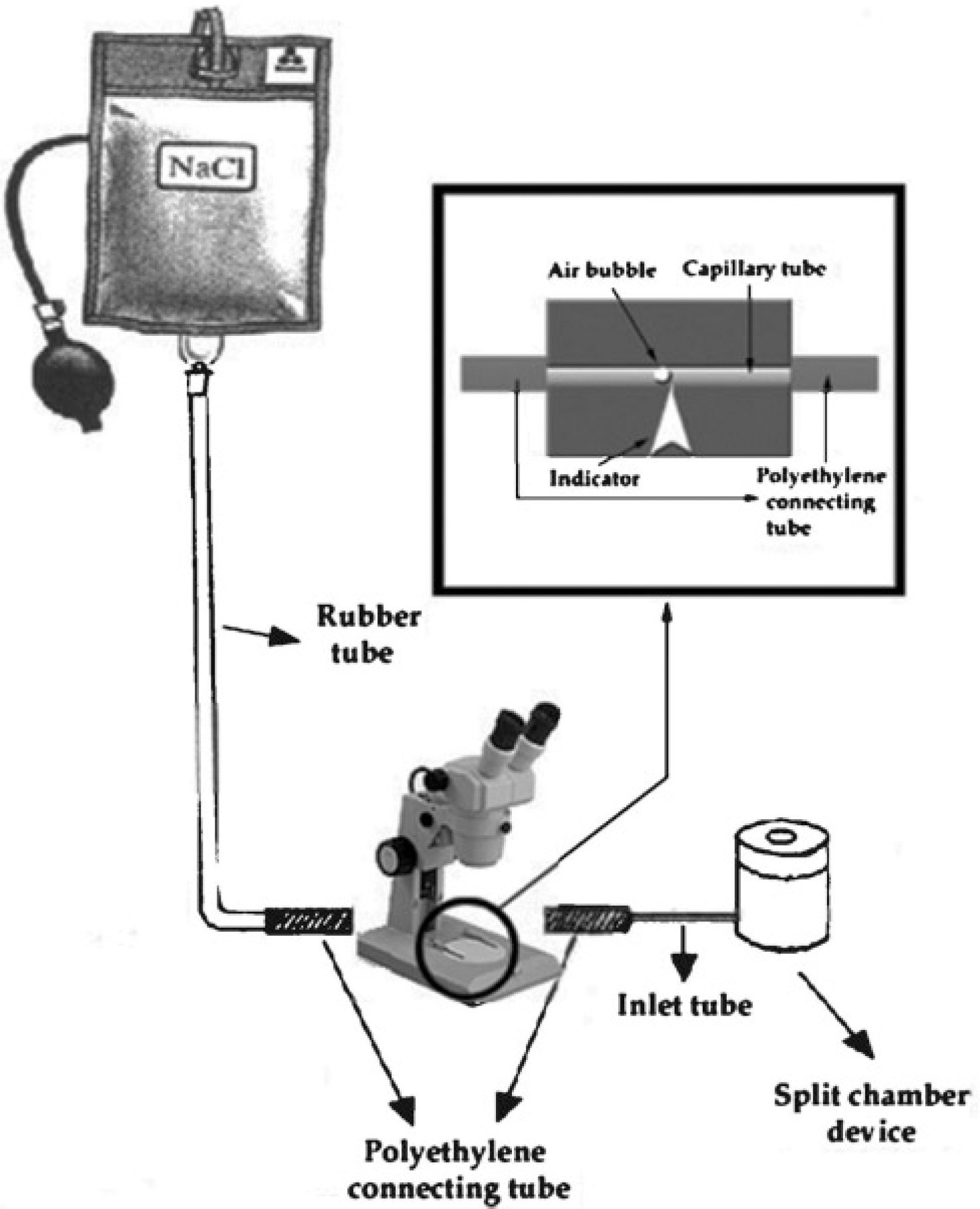 | Fig. 1.Schematic view of Pashley's device used to measure hydraulic conductance of dentin disc. |
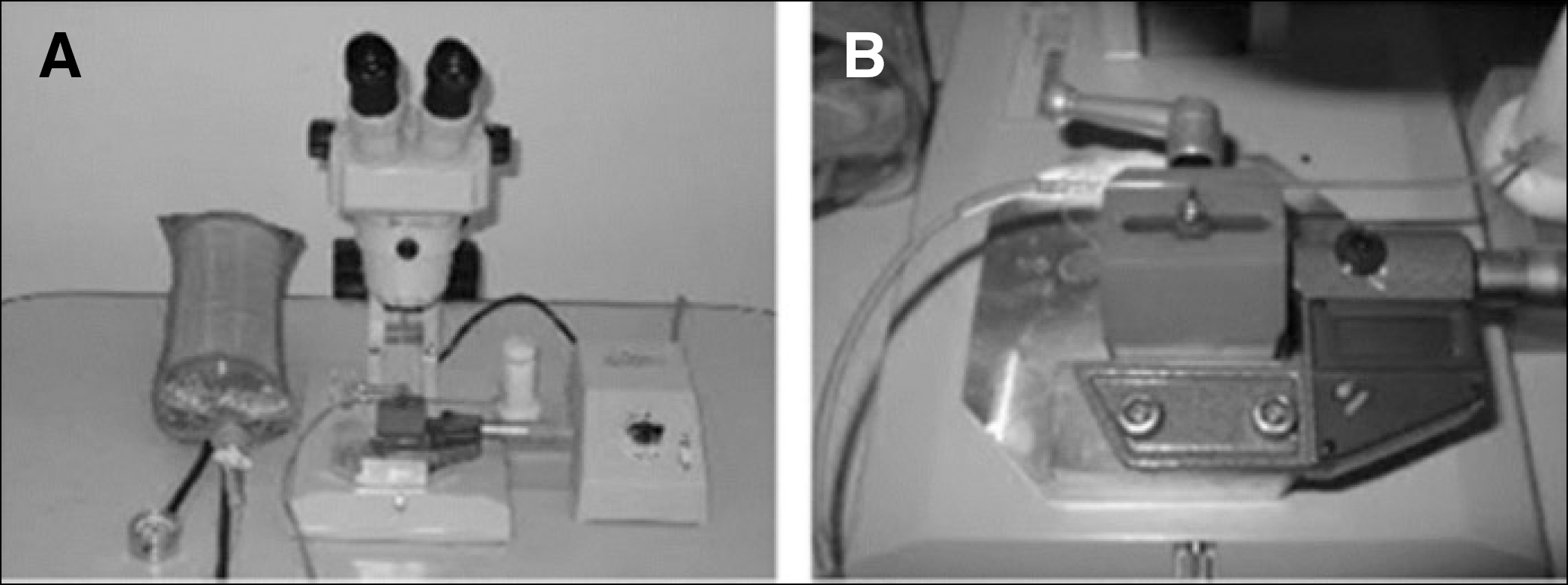 | Fig. 2.Photograph of Pashley's device used to measure hydraulic conductance of dentin disc (A); digital micrometer (B). |
 | Fig. 4.All-Bond® 2 and All-Bond® 2 + Bonding resin: % change values of hydraulic conductance. |
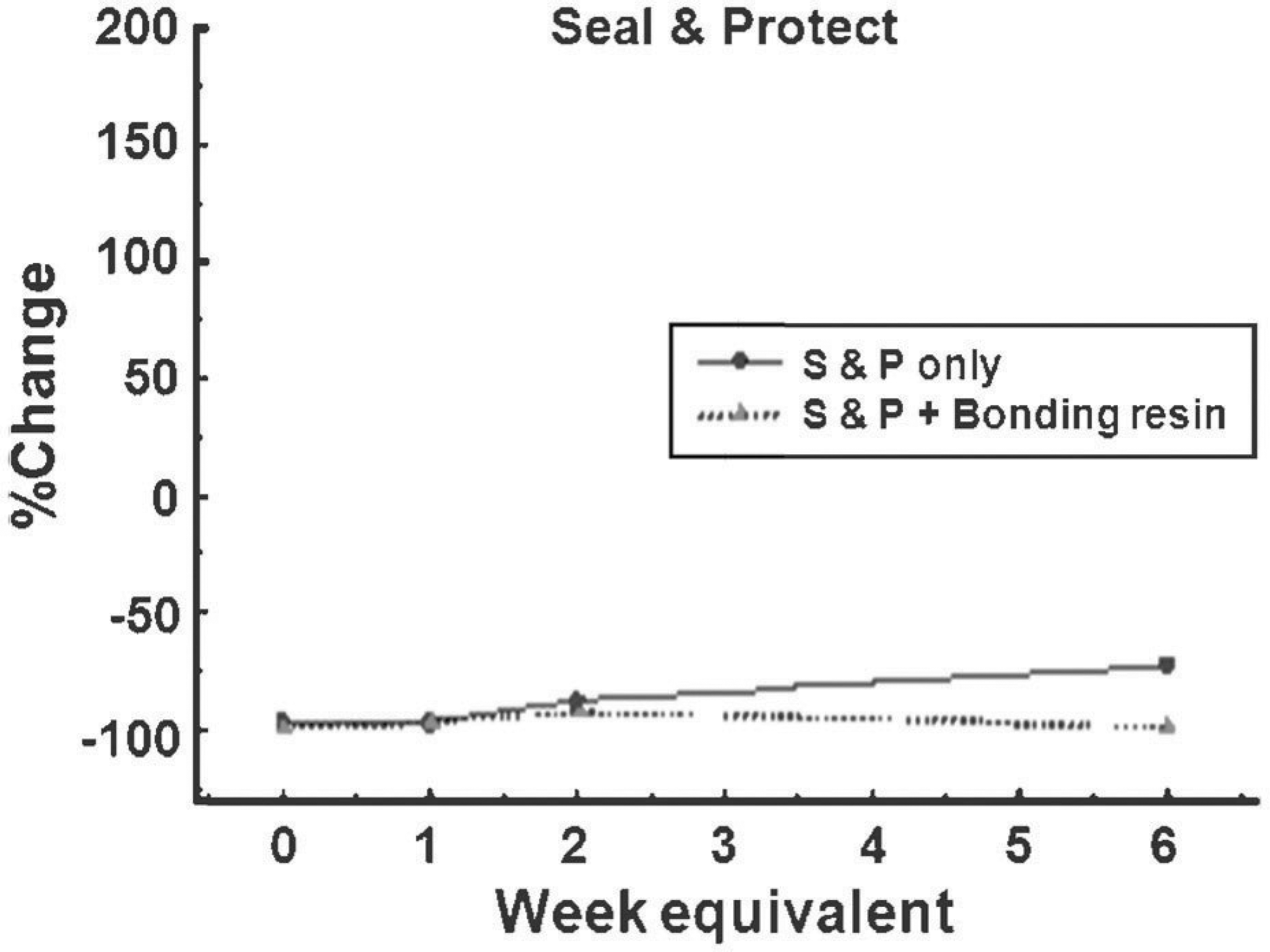 | Fig. 5.Seal & Protect® and Seal & Protect® + Bonding resin: % change values of hydraulic conductance. |
 | Fig. 8.(A) All-Bond® 2: SEM of dentinal surface after agent treatment, (B) All-Bond® 2: SEM of dentinal surface after 6-week tooth brushing, (C) All-Bond® 2 + Bonding resin: SEM of dentinal surface after agent treatment, (D) All-Bond® 2 + Bonding resin: SEM of dentinal surface after 6-week tooth brushing. |
 | Fig. 9.(A) Seal & Protect®: SEM of dentinal surface before agent treatment, (B) Seal & Protect®: SEM of dentinal surface after agent treatment, (C) Seal & Protect®: SEM of dentinal surface after 6-week tooth brushing, (D) Seal & Protect® + Bonding resin: SEM of dentinal surface after 6-week tooth brushing. |
 | Fig. 10.(A) Gluma®: SEM of dentinal surface before agent treatment, (B) Gluma®: SEM of dentinal surface after agent treatment, (C) Gluma®: SEM of dentinal surface after 6-week tooth brushing, (D) Gluma® + Bonding resin: SEM of dentinal surface after 6-week tooth brushing. |
 | Fig. 11.(A) MS Coat®: SEM of dentinal surface before agent treatment, (B) MS Coat®: SEM of dentinal surface after agent treatment, (C) MS Coat®: SEM of dentinal surface after 6-week tooth brushing, (D) MS Coat® + Bonding resin: SEM of dentinal surface after 6-week tooth brushing. |
Table 1.
Desensitizing agents and bonding resin used in this study
Table 2.
Mean of Lp values and % change values
Table 3.
Comparison of % change values before and after treatment in 8 groups (Wilcoxon signed rank test)
| % change 2 - % change 1 | % change 3 - % change 2 | % change 4 - % change 3 | |
|---|---|---|---|
| All-Bond 2 | 0.018∗ | 0.018∗ | 0.028∗ |
| All-Bond2 + Bonding resin | 0.463 | 0.028∗ | 0.018∗ |
| Seal&Protect | 0.612 | 0.018∗ | 0.499 |
| Seal&Protect + Bonding resin | 0.310 | 0.028∗ | 0.063 |
| Gluma | 0.018∗ | 0.018∗ | 0.398 |
| Gluma + Bonding resin | 0.735 | 0.176 | 0.612 |
| MS Coat | 0.018∗ | 0.018∗ | 0.091 |
| MS Coat + Bonding resin | 0.018∗ | 0.018∗ | 0.735 |
Table 4.
Comparison of % change values before and after treatment in 8 groups (Mann-Whitney Test)
| % change 1 | % change 2 | % change 3 | % change 4 | |
|---|---|---|---|---|
| All-Bond 2® vs. All-Bond 2® + Bonding resin | 0.225 | 0.004∗ | 0.013∗ | 0.003∗ |
| Seal&Protect® vs. Seal&Protect® + Bonding Resin | 0.142 | 0.848 | 0.565 | 0.018∗ |
| Gluma® vs. Gluma® + Bonding resin | 0.338 | 0.035∗ | 0.006∗ | 0.004∗ |
| MS Coat® vs. MS Coat® + Bonding resin | 0.223 | 0.025∗ | 0.048∗ | 0.035∗ |




 PDF
PDF ePub
ePub Citation
Citation Print
Print


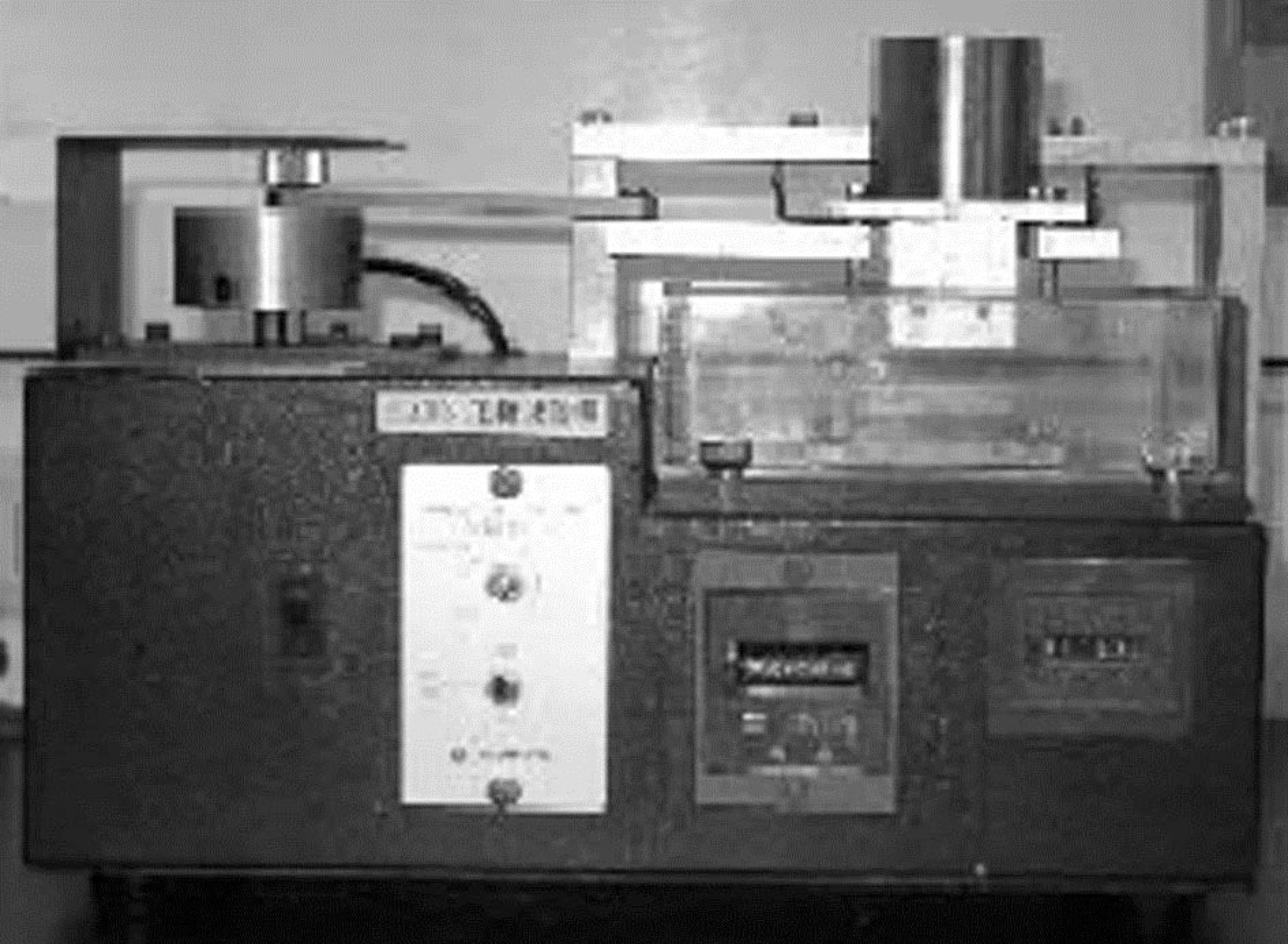
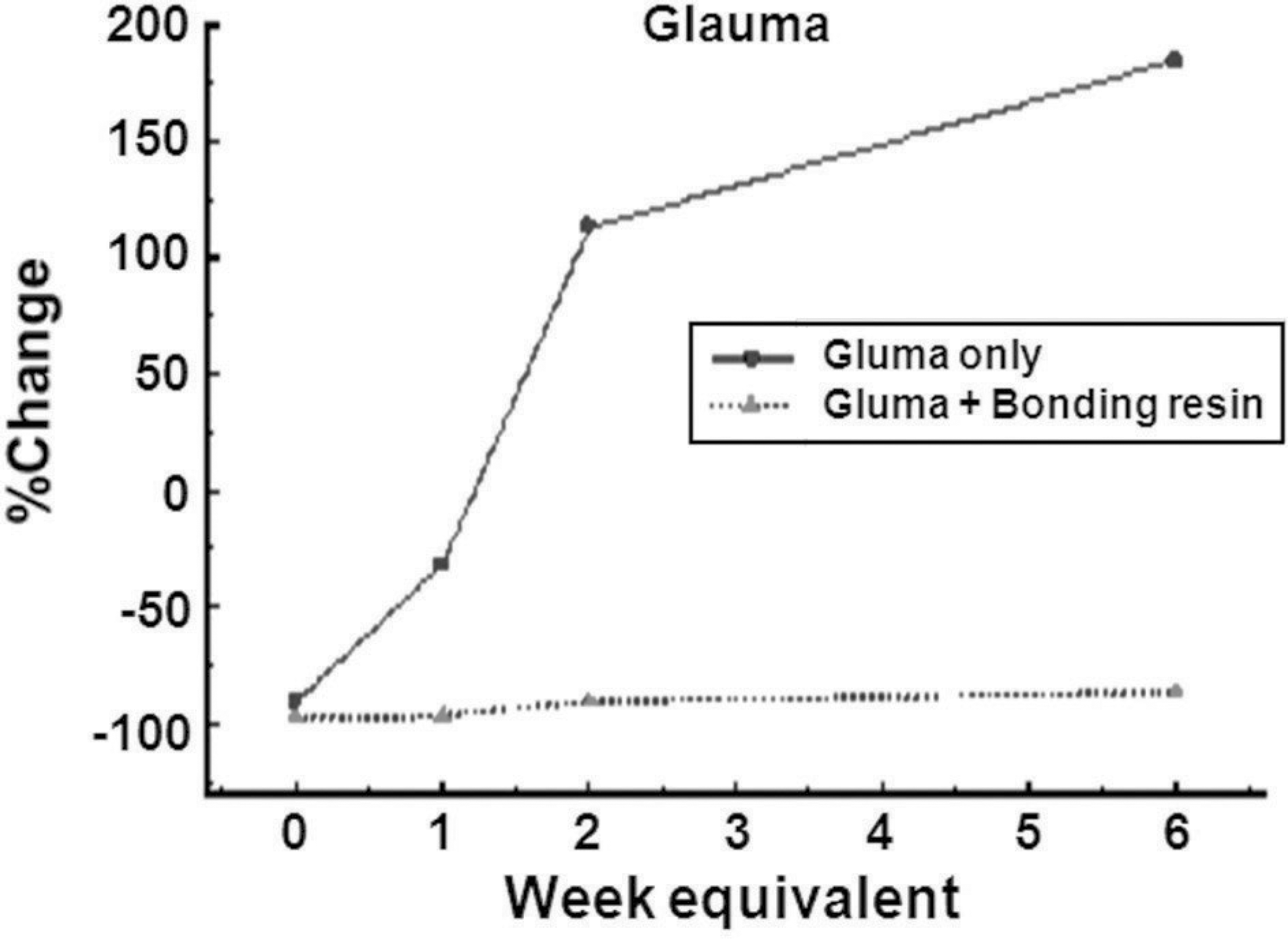
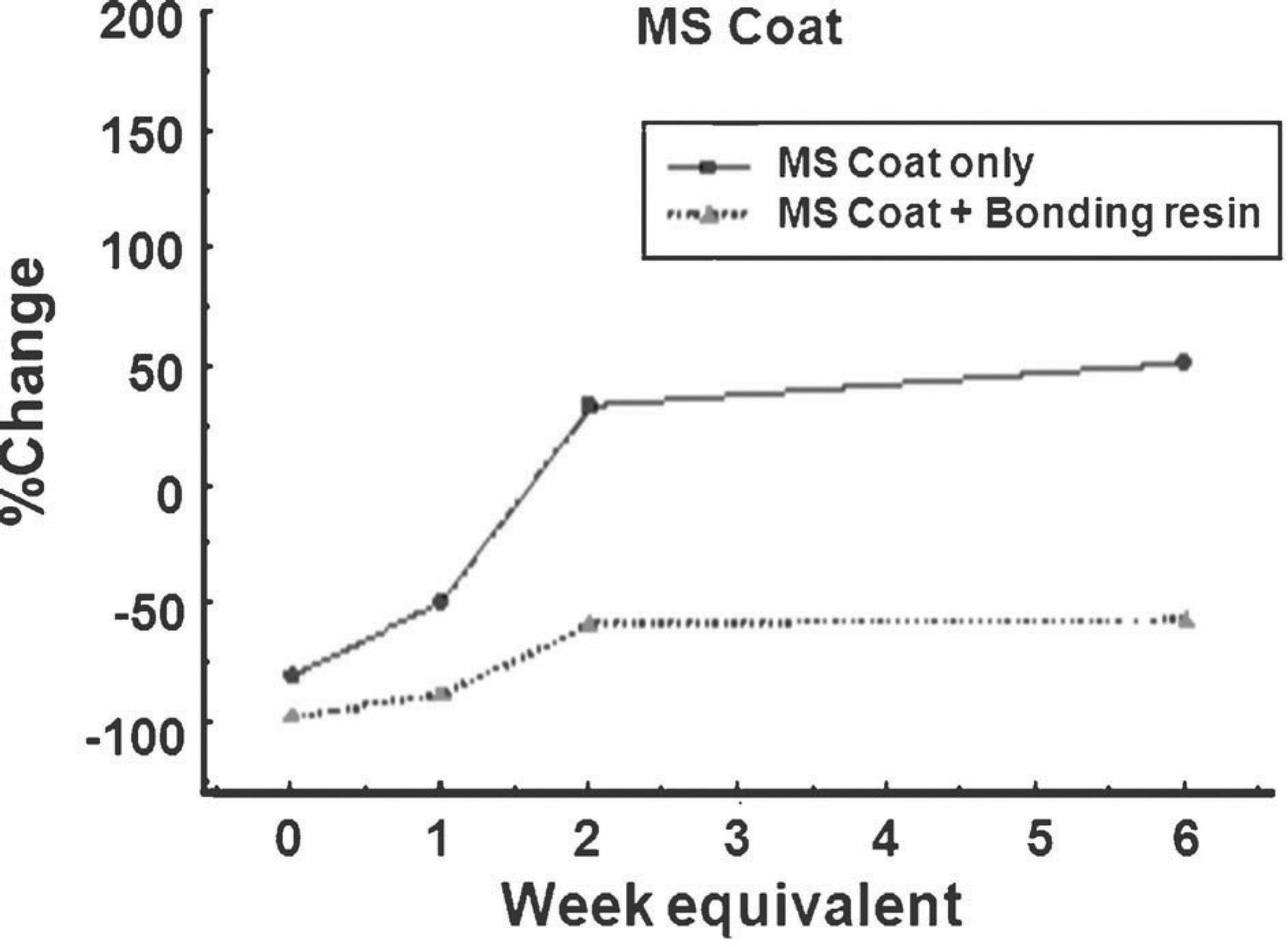
 XML Download
XML Download